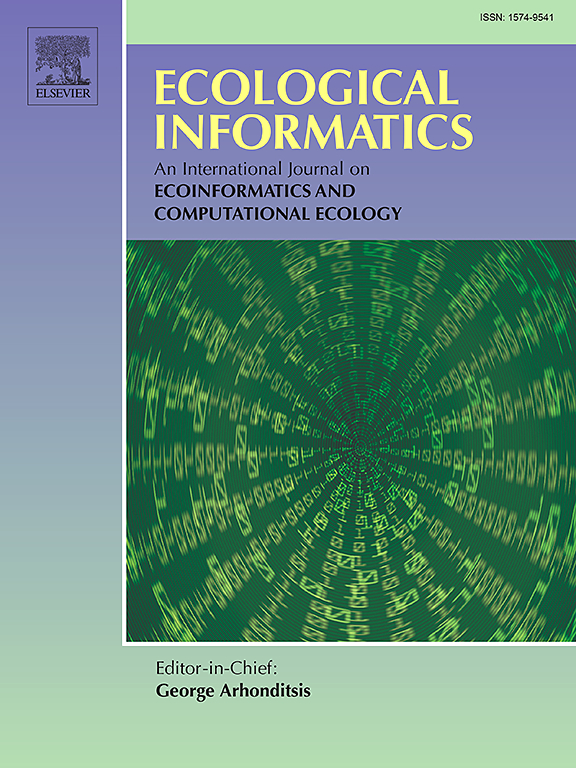A synergistic UAV-Landsat novel strategy for enhanced estimation of above-ground biomass and shrub dominance in Sandy land
IF 7.3
2区 环境科学与生态学
Q1 ECOLOGY
引用次数: 0
Abstract
Accurate estimation of above-ground biomass (AGB) and shrub dominance in sandy lands is crucial for monitoring desertification risk and guiding effective management policies. This study proposed a novel strategy for large-scale AGB estimation in sandy landscapes, focusing on Horqin Sandy Land, by integrating ground reference data with unmanned aerial vehicle (UAV) observations and Landsat 8 OLI imagery. This integration enhanced both the accuracy and efficiency of mapping AGB and shrub dominance. Initially, UAV data were employed to classify shrub and herbaceous vegetation using an object-oriented method, followed by estimating shrub and herbaceous AGB using an allometric growth model (AGM) and partial least squares regression (PLSR). UAV-derived biomass estimates were then aggregated into landscape-scale samples and combined with Landsat imagery to develop Shapley Additive explanation-extreme gradient boosting (SHAP-XGBoost) models for shrub and total AGB. Finally, shrub dominance was mapped as the shrub AGB /total AGB across the region. At the plot scale, AGM coupled with shrub volume provided the highest accuracy for shrub AGB estimation (R2 = 0.97, MAE = 176.24 g). Visible-light features from UAV data significantly contributed to herbaceous AGB estimation, achieving a PLSR model accuracy of R2 of 0.91 and an MAE of 14.76 g/m2. At the landscape scale, the SHAP-XGBoost models demonstrated excellent accuracy, yielding R2 values of 0.78 (MAE = 14.96 g/m2) for shrub AGB and 0.83 (MAE = 30.47 g/m2) for total AGB. These high-precision estimation results facilitated the mapping of the shrub dominance.
UAV-Landsat协同估算沙地地上生物量和灌木优势度的新策略
准确估算沙地地上生物量(AGB)和灌木优势度对于监测沙漠化风险和指导有效的管理政策至关重要。本文以科尔沁沙地为研究对象,提出了一种基于地面参考数据、无人机(UAV)观测数据和Landsat 8 OLI影像的沙地景观大尺度AGB估算新策略。这种整合提高了AGB和灌木优势度制图的准确性和效率。首先,利用无人机数据采用面向对象方法对灌木和草本植被进行分类,然后利用异速生长模型(AGM)和偏最小二乘回归(PLSR)估计灌木和草本植被的AGB。然后将无人机获得的生物量估算汇总到景观尺度样本中,并与Landsat图像相结合,开发了灌木和总AGB的Shapley Additive解释-极端梯度增强(SHAP-XGBoost)模型。最后,将灌木优势度映射为灌木AGB /总AGB。在样地尺度上,AGM与灌木体积的耦合对灌木AGB的估计精度最高(R2 = 0.97, MAE = 176.24 g)。无人机数据的可见光特征对草本植物AGB估算有显著贡献,PLSR模型精度R2为0.91,MAE为14.76 g/m2。在景观尺度上,SHAP-XGBoost模型具有良好的准确性,灌木AGB的R2值为0.78 (MAE = 14.96 g/m2),总AGB的R2值为0.83 (MAE = 30.47 g/m2)。这些高精度的估算结果为灌丛优势度的绘制提供了便利。
本文章由计算机程序翻译,如有差异,请以英文原文为准。
求助全文
约1分钟内获得全文
求助全文
来源期刊

Ecological Informatics
环境科学-生态学
CiteScore
8.30
自引率
11.80%
发文量
346
审稿时长
46 days
期刊介绍:
The journal Ecological Informatics is devoted to the publication of high quality, peer-reviewed articles on all aspects of computational ecology, data science and biogeography. The scope of the journal takes into account the data-intensive nature of ecology, the growing capacity of information technology to access, harness and leverage complex data as well as the critical need for informing sustainable management in view of global environmental and climate change.
The nature of the journal is interdisciplinary at the crossover between ecology and informatics. It focuses on novel concepts and techniques for image- and genome-based monitoring and interpretation, sensor- and multimedia-based data acquisition, internet-based data archiving and sharing, data assimilation, modelling and prediction of ecological data.
 求助内容:
求助内容: 应助结果提醒方式:
应助结果提醒方式:


